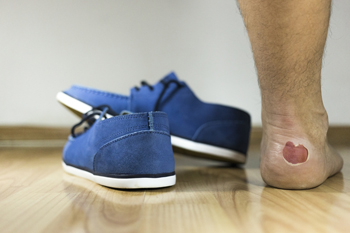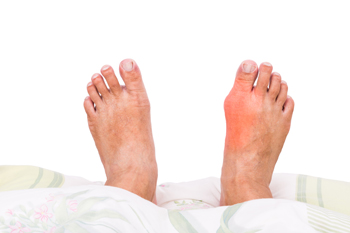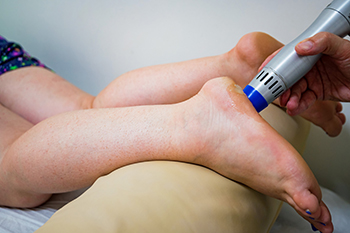October 2023
Foot Blisters May Require Treatment

A blister is a fluid-filled sac that forms on the skin due to repetitive friction. This typically arises when skin continually rubs against objects, such as the inside of shoes. The friction causes skin layers to separate, prompting the body to fill the void with fluid as a protective mechanism against further harm. Blisters can be painful, especially when wearing shoes that contribute to the friction. They are common and can be attributed to factors like poorly fitting shoes, foot deformities, sweat, prolonged exercise, or using unsuitable socks. It is advisable to refrain from popping blisters, as this exposes the wound to potential infections. Instead, protect it with a bandage and eliminate the friction source. There are other conditions with symptoms resembling blisters, such as impetigo, eczema, and burns. If you have a foot blister that does not heal in a reasonable time, worsens, or appears infected, it is suggested that you make an appointment with a podiatrist who can distinguish it from other ailments, treat it, and provide prevention tips.
Blisters are prone to making everyday activities extremely uncomfortable. If your feet are hurting, contact John Killough, DPM of Regional Foot Center. Our doctor can provide the care you need to keep you pain-free and on your feet.
Foot Blisters
Foot blisters develop as a result of constantly wearing tight or ill-fitting footwear. This happens due to the constant rubbing from the shoe, which can often lead to pain.
What Are Foot Blisters?
A foot blister is a small fluid-filled pocket that forms on the upper-most layer of the skin. Blisters are filled with clear fluid and can lead to blood drainage or pus if the area becomes infected.
How Do Blisters Form?
Blisters on the feet are often the result of constant friction of skin and material, usually by shoe rubbing. Walking in sandals, boots, or shoes that don’t fit properly for long periods of time can result in a blister. Having consistent foot moisture and humidity can easily lead to blister formation.
Prevention & Treatment
It is important to properly care for the affected area in order to prevent infection and ease the pain. Do not lance the blister and use a Band-Aid to provide pain relief. Also, be sure to keep your feet dry and wear proper fitting shoes. If you see blood or pus in a blister, seek assistance from a podiatrist.
If you have any questions, please feel free to contact our offices located in Charleston and Effingham, IL . We offer the newest diagnostic and treatment technologies for all your foot care needs.
The Development of a Bunion

Bunions, a common foot condition, can cause significant discomfort and affect daily life. Understanding the causes behind their development is important in finding effective preventive measures and treatments. Often, bunions are inherited, as a result of genetic factors influencing foot structure and mechanics. Wearing tight or ill-fitting shoes, especially those with pointed toes or high heels, can exert pressure on the toes and contribute to bunion formation. Foot stress and overuse, commonly seen in athletes or individuals with occupations that require prolonged standing, can also aggravate bunions. Additionally, medical conditions such as arthritis may increase the risk of developing bunions. Gender plays a role, with women being more susceptible due to wearing footwear that cramps the toes. Recognizing these causes empowers individuals to make informed choices regarding footwear and foot care. If you have a bunion, it is suggested that you are under the care of a podiatrist who can help you to manage this condition, and offer potential relief options.
If you are suffering from bunions, contact John Killough, DPM of Regional Foot Center. Our doctor can provide the care you need to keep you pain-free and on your feet.
What Is a Bunion?
A bunion is formed of swollen tissue or an enlargement of boney growth, usually located at the base joint of the toe that connects to the foot. The swelling occurs due to the bones in the big toe shifting inward, which impacts the other toes of the foot. This causes the area around the base of the big toe to become inflamed and painful.
Why Do Bunions Form?
Genetics – Susceptibility to bunions are often hereditary
Stress on the feet – Poorly fitted and uncomfortable footwear that places stress on feet, such as heels, can worsen existing bunions
How Are Bunions Diagnosed?
Doctors often perform two tests – blood tests and x-rays – when trying to diagnose bunions, especially in the early stages of development. Blood tests help determine if the foot pain is being caused by something else, such as arthritis, while x-rays provide a clear picture of your bone structure to your doctor.
How Are Bunions Treated?
- Refrain from wearing heels or similar shoes that cause discomfort
- Select wider shoes that can provide more comfort and reduce pain
- Anti-inflammatory and pain management drugs
- Orthotics or foot inserts
- Surgery
If you have any questions, please feel free to contact our offices located in Charleston and Effingham, IL . We offer the newest diagnostic and treatment technologies for all your foot care needs.
Causes and Symptoms of Athlete’s Foot

Athlete's foot, scientifically known as tinea pedis, is a fungal infection that can affect anyone. It is notorious for causing discomfort, itching, and unsightly skin changes. Athlete’s foot tends to be more prevalent among older adults, especially males. The primary cause is dermatophytes, a type of fungus that thrive in warm and humid environments. You can contract athlete's foot by walking barefoot on wet and contaminated floors, especially in public areas like locker rooms, showers, and pools. It also can be transmitted by sharing towels, clothing, or shoes with someone who has the infection. Prolonged use of sweaty, tight shoes that create a moist environment for fungi to flourish also increases the risk of infection. Symptoms of athlete's foot can include red and inflamed skin, persistent itchiness, flaky and scaly skin, thickened skin, and dry feet. In severe cases, tiny red blisters may develop between the toes or on the soles of the feet. The good news is that athlete's foot is generally easy to treat with prescribed antifungal creams or oral medications. If you suspect you have a particularly troublesome case of athlete's foot, it is suggested that you make an appointment with a podiatrist for help managing this fungal infection.
Athlete’s foot is an inconvenient condition that can be easily reduced with the proper treatment. If you have any concerns about your feet and ankles, contact John Killough, DPM from Regional Foot Center. Our doctor will treat your foot and ankle needs.
Athlete’s Foot: The Sole Story
Athlete's foot, also known as tinea pedis, can be an extremely contagious foot infection. It is commonly contracted in public changing areas and bathrooms, dormitory style living quarters, around locker rooms and public swimming pools, or anywhere your feet often come into contact with other people.
Solutions to Combat Athlete’s Foot
- Hydrate your feet by using lotion
- Exfoliate
- Buff off nails
- Use of anti-fungal products
- Examine your feet and visit your doctor if any suspicious blisters or cuts develop
Athlete’s foot can cause many irritating symptoms such as dry and flaking skin, itching, and redness. Some more severe symptoms can include bleeding and cracked skin, intense itching and burning, and even pain when walking. In the worst cases, Athlete’s foot can cause blistering as well. Speak to your podiatrist for a better understanding of the different causes of Athlete’s foot, as well as help in determining which treatment options are best for you.
If you have any questions please feel free to contact our offices located in Charleston and Effingham, IL . We offer the newest diagnostic and treatment technologies for all your foot and ankle needs.
Trench Foot

Trench foot, also known as immersion foot syndrome, is a serious condition resulting from prolonged exposure of the feet to moisture. It damages the circulation and nerve function in the feet. Its history goes back to World War I when soldiers in cold, wet trenches suffered from it due to wearing inadequate footwear. The symptoms of trench foot include blisters, blotchy skin, redness, and possibly tissue loss. It can also cause sensations such as coldness, numbness, and persistent itching. Trench foot is primarily caused by wet feet that do not dry properly, with temperatures that are 30˚F to 40˚F being most conducive. Early treatment is essential, and, if left untreated, trench foot can lead to severe complications such as amputations, gangrene, and permanent nerve damage. Diagnosis involves a physical examination by a doctor to assess injuries, tissue loss, and circulation. Treatment mainly consists of rest, elevation, pain medications, and keeping the feet clean and dry. Prevention includes keeping feet dry, having spare socks and shoes on hand, and airing out feet after wearing socks and shoes, even if they do not appear wet. If you have sustained prolonged exposure of your feet to moisture and have symptoms that are worsening, it is strongly suggested that you make an appointment with a podiatrist as soon as possible for a proper diagnosis and treatment.
Foot Pain
Foot pain can be extremely painful and debilitating. If you have a foot pain, consult with John Killough, DPM from Regional Foot Center. Our doctor will assess your condition and provide you with quality foot and ankle treatment.
Causes
Foot pain is a very broad condition that could be caused by one or more ailments. The most common include:
- Bunions
- Hammertoes
- Plantar Fasciitis
- Bone Spurs
- Corns
- Tarsal Tunnel Syndrome
- Ingrown Toenails
- Arthritis (such as Gout, Rheumatoid, and Osteoarthritis)
- Flat Feet
- Injury (from stress fractures, broken toe, foot, ankle, Achilles tendon ruptures, and sprains)
- And more
Diagnosis
To figure out the cause of foot pain, podiatrists utilize several different methods. This can range from simple visual inspections and sensation tests to X-rays and MRI scans. Prior medical history, family medical history, and any recent physical traumatic events will all be taken into consideration for a proper diagnosis.
Treatment
Treatment depends upon the cause of the foot pain. Whether it is resting, staying off the foot, or having surgery; podiatrists have a number of treatment options available for foot pain.
If you have any questions, please feel free to contact our offices located in Charleston and Effingham, IL . We offer the newest diagnostic and treatment technologies for all your foot care needs.
Plantar Warts Can Be Treated!
Harnessing MLS Therapy for Peroneal Pain Relief

Peroneal pain is a common challenge arising from injuries or strain to the lower leg and foot peroneal muscles, often disrupting mobility and well-being. Multiwave Locked System, abbreviated MLS therapy is a groundbreaking technique that offers relief from this discomfort. MLS therapy addresses peroneal pain thoroughly by utilizing synchronized wavelengths of laser light. The continuous wavelength triggers the release of natural pain relievers, swiftly alleviating discomfort, while the pulsed wavelength encourages cellular repair and diminishes inflammation. This dual-pronged approach not only provides relief but also accelerates healing, enabling individuals to regain their stride sooner. The non-invasive nature of MLS therapy ensures minimal disruption to daily life, making it an attractive relief option for peroneal pain. If you have this type of pain, it is suggested that you confer with a podiatrist who can determine if this treatment is right for you.
MLS Laser Therapy is a successful alternative for treating any pain you may be experiencing related to certain podiatric conditions. If you are interested in MLS Laser Therapy, consult with John Killough, DPM from Regional Foot Center. Our doctor will assess your condition and provide you with quality foot and ankle treatment.
MLS Laser Therapy
Multiwave Locked System (MLS) Laser Therapy is a patented, FDA-cleared technology that helps relieve pain and inflammation from a number of podiatric conditions, including:
- Heel Pain
- Plantar Fasciitis
- Sports Injuries
- Wounds
- Achilles Tendonitis
- Arthritis
- Neuropathy
- Neuromas
MLS Laser Therapy is an ideal alternative to surgery and prescription medication, as it has no negative side effects and encourages accelerated healing. Among its many clinical benefits, MLS Laser Therapy also:
- Reduces swelling due to bruising or inflammation
- Blocks pain
- Reduces formation of scar tissue
- Improves nerve function
If you have any questions, please feel free to contact our offices located in Charleston and Effingham, IL . We offer the newest diagnostic and treatment technologies for all your foot care needs.





